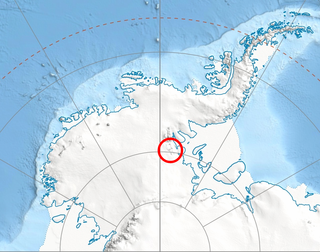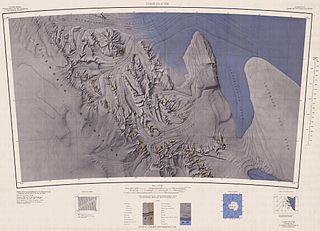Related Research Articles
The Forrestal Range is a largely snow-covered mountain range, about 105 km (65 mi) long, standing east of Dufek Massif and the Neptune Range in the Pensacola Mountains of Antarctica. Discovered and photographed on 13 January 1956 on a transcontinental patrol plane flight of U.S. Navy Operation Deep Freeze I from McMurdo Sound to the vicinity of the Weddell Sea and return.

Muir Peak is a conspicuous rock peak near the middle of Frazier Ridge in the Founders Peaks, Heritage Range. It was mapped by the United States Geological Survey (USGS) from surveys and U.S. Navy air photos from 1961 to 1966. It was named by the Advisory Committee on Antarctic Names (US-ACAN) for Hugh M. Muir, a United States Antarctic Research Program (USARP) auroral scientist and member of the winter party at the Plateau Station in 1966.
Beard Peak is a peak 2,360 metres (7,740 ft) high, along the north edge of the La Gorce Mountains, standing 4 nautical miles (7 km) south of the eastern tip of Mount Mooney in Antarctica. It was mapped by the United States Geological Survey from surveys and from U.S. Navy air photos, 1960–63, and named by the Advisory Committee on Antarctic Names for Philip H. Beard, a photographer with U.S. Navy Squadron VX-6 during Operation Deep Freeze 1966 and 1967.

Mount Bursik is the central peak, 2,500 metres (8,200 ft) high, of the Soholt Peaks, in the Heritage Range, Ellsworth Mountains. It was mapped by the United States Geological Survey from ground surveys and from U.S. Navy air photos, 1961–66, and named by the Advisory Committee on Antarctic Names for Captain Vlada D. Bursik, U.S. Navy, Deputy Commander, U.S. Navy Support Force, Antarctica, during Operation Deep Freeze 1966.
Unger Peak is a conspicuous, mainly ice-covered peak which rises above the plateau at the south end of Founders Escarpment. It stands 2 nautical miles (3.7 km) north-northwest of Zavis Peak in the Heritage Range, Ellsworth Mountains. It was mapped by the United States Geological Survey (USGS) from surveys and U.S. Navy air photos from 1961 to 1966. It was named by the Advisory Committee on Antarctic Names (US-ACAN) for Lieutenant Maurice H. Unger of the U.S. Navy, a navigator on photographic flights over Marie Byrd and Ellsworth Lands during Operation Deep Freeze 1965 and 1966.
Courtney Peak is a peak, 1,060 metres (3,480 ft) high, in the northern part of the Gross Hills, Heritage Range. It was mapped by the United States Geological Survey from surveys and from U.S. Navy air photos, 1961–66, and named by the Advisory Committee on Antarctic Names for electronics technician Kenneth N. Courtney, U.S. Navy, who through Operation Deep Freeze 1966 contributed to efficient communications during six austral summer seasons.
Cunningham Peak is a mainly ice-covered peak, 2,170 metres (7,120 ft) high, at the head of Gowan Glacier along the Founders Escarpment, in the Heritage Range. It was mapped by the United States Geological Survey from surveys and from U.S. Navy air photos, 1961–66, and named by the Advisory Committee on Antarctic Names for Ship's Serviceman John B. Cunningham, U.S. Navy, in charge of the McMurdo Station ship's store and laundry during U.S. Navy Operation Deep Freeze 1966.
Guarcello Peak is a peak, 2,050 metres (6,730 ft) high, located 3.5 nautical miles (6 km) south-southeast of Mount Dolence in the Enterprise Hills of the Heritage Range in Antarctica. It was mapped by the United States Geological Survey from surveys and U.S. Navy air photos from 1961 to 1966, and was named by the Advisory Committee on Antarctic Names for Dominic Guarcello, a meteorologist at Little America V Station in 1958. Guarcello Peak was first successfully climbed on December 23, 2011, by Simon Abrahams, Ralf Laier and Todd Passey.

Gowan Glacier is a glacier about 15 nautical miles long in the Heritage Range of the Ellsworth Mountains of Antarctica, flowing north from the vicinity of Cunningham Peak in the Founders Escarpment to enter Minnesota Glacier just east of Welcome Nunatak. It was mapped by the United States Geological Survey from surveys and U.S. Navy air photos, 1961–66, and was named by the Advisory Committee on Antarctic Names for Lieutenant Jimmy L. Gowan, U.S. Navy Medical Corps, officer in charge and doctor at Plateau Station in 1966.
Pipe Peak is a sharp peak on a ridge, 1,720 m, rising 1.5 nautical miles (2.8 km) north of Matney Peak in the Founders Peaks, Heritage Range. It was named so by members of the University of Minnesota Geological Party of 1963–64 because a pipe was left here after a visit to the area.
Pardue Peak is the northernmost peak, 1,840 m, on Smith Ridge in the Founders Peaks, Heritage Range. It was mapped by the United States Geological Survey (USGS) from surveys and U.S. Navy air photos from 1961 to 1966. It was named by the Advisory Committee on Antarctic Names (US-ACAN) for Lieutenant A. Michael Pardue, (MC) U.S. Navy, who was a Flight Surgeon with Squadron VX-6 in Antarctica in 1960–61.
Fendorf Glacier is a broad glacier draining from the eastern slopes of the Gifford Peaks and flowing north to merge with Dobbratz Glacier, in the Heritage Range of the Ellsworth Mountains, Antarctica. It was mapped by the United States Geological Survey from ground surveys and U.S. Navy air photos, 1961–66, and was named by the Advisory Committee on Antarctic Names for Lieutenant Commander James E. Fendorf, U.S. Navy, a pilot with Squadron VX-6 during Operation Deep Freeze 1966.
The Founders Peaks are a cluster of sharp peaks and ridges located just east of Founders Escarpment and between Minnesota Glacier and Gowan Glacier, in the Heritage Range of the Ellsworth Mountains in Antarctica. The peaks were mapped by the United States Geological Survey from surveys and U.S. Navy air photos, 1961–66. The name was applied by the Advisory Committee on Antarctic Names is association with the name Heritage Range.

Goff Glacier is a broad glacier flowing from Parker Peak into the head of Koether Inlet on the north side of Thurston Island, Antarctica. It was named by the Advisory Committee on Antarctic Names after Lieutenant Robert G. Goff, co-pilot of PBM Mariner aircraft in the Eastern Group of U.S. Navy Operation Highjump, which obtained aerial photographs of Thurston Island and adjacent coastal areas, 1946–47.
Mink Peak is a prominent peak standing 2 nautical miles (4 km) north of Cleveland Mesa, at the east end of the Watson Escarpment in Antarctica. It was mapped by the United States Geological Survey from surveys and U.S. Navy air photos, 1960–64, and was named by the Advisory Committee on Antarctic Names for Harold D. Mink, a utilitiesman with the wintering parties at Byrd Station in 1962 and 1966.
Howe Glacier is a short tributary glacier draining west into Scott Glacier immediately north of Mount Russell, in the Queen Maud Mountains of Antarctica. It was mapped by the United States Geological Survey from surveys and U.S. Navy air photos, 1960–63, and was named by the Advisory Committee on Antarctic Names for Robert C. Howe of U.S. Navy Squadron VX-6, a photographer on Operation Deep Freeze 1966 and 1967.
Huggler Peak is a sharp snow-covered peak, 1,580 metres (5,180 ft) high, in the northern part of Anderson Massif, in the Heritage Range of the Ellsworth Mountains, Antarctica. It was mapped by the United States Geological Survey from surveys and U.S. Navy air photos from 1961 to 1966, and was named by the Advisory Committee on Antarctic Names for John Q. Huggler, a U.S. Navy Reserve storekeeper who assisted in various construction projects at McMurdo Station during U.S. Navy Operation Deep Freeze in 1966.
Hutto Peak is a sharp peak, 1,620 metres (5,300 ft) high, standing just below the Founders Escarpment on the ridge separating the upper portions of Gowan Glacier and Splettstoesser Glacier, in the Heritage Range of mountains in Antarctica. It was mapped by the United States Geological Survey from surveys and U.S. Navy air photos from 1961 to 1966, and was named by the Advisory Committee on Antarctic Names for Chief Yoeman Grey H. Hutto of the U.S. Navy who was a participant in Operation Deep Freeze in two austral seasons in Antarctica in the period 1964–66.
Lamb Peak is a conspicuous bare rock peak located 2 nautical miles (4 km) south-southeast of Maagoe Peak in the Gifford Peaks of the Heritage Range, Ellsworth Mountains, Antarctica. It was mapped by the United States Geological Survey from surveys and U.S. Navy air photos from 1961 to 1966, and was named by the Advisory Committee on Antarctic Names for Lieutenant Commander Arthur D. Lamb, who contributed to the success of austral summer resupply activities for three seasons in his capacity as operations and communications officer through U.S. Navy Operation Deep Freeze 1966.
Lee Peak is a peak along the west side of Scott Glacier, 3 nautical miles (6 km) north of Mount Denauro, in the Queen Maud Mountains of Antarctica. It was mapped by the United States Geological Survey from surveys and U.S. Navy air photos, 1960–64, and was named by the Advisory Committee on Antarctic Names for Frank P. Lee, a photographer on aerial flights in Antarctica during U.S. Navy Operation Deep Freeze 1965, 1966 and 1967.
References
- ↑ "Matney Peak". Geographic Names Information System . United States Geological Survey, United States Department of the Interior . Retrieved 29 August 2013.
![]() This article incorporates public domain material from "Matney Peak". Geographic Names Information System . United States Geological Survey.
This article incorporates public domain material from "Matney Peak". Geographic Names Information System . United States Geological Survey.
